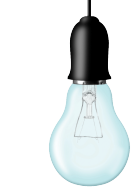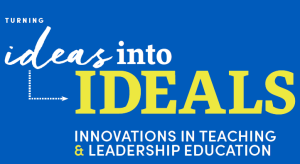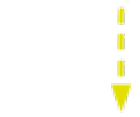Turning Ideas into Ideals: Innovations in Teaching and Leadership Education
“I am proud of GSE’s experimental spirit and stubborn refusal to stick with the status quo.”
—Suzanne Rosenblith, Dean
Ideas:

Preparing Aspiring Teachers
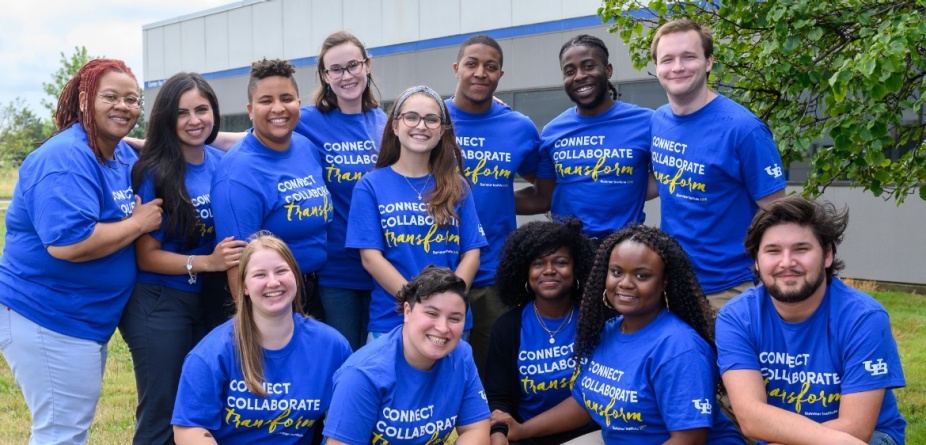
Sydney Favors, one of 13 students in the inaugural UB Teacher Residency Program (UBTR) cohort, was once a student in the Buffalo Public Schools (BPS). Now, as a teacher resident, Favors wants to become a positive and motivating force in the lives of students in urban schools. “Students that live in cities like Buffalo need teachers that can relate to their experiences as a member of an underrepresented group,” says Favors (see resident profiles).
In fall 2018, GSE launched UBTR, which is a partnership between GSE and BPS. This collaboration is an innovative pathway for prospective teachers who want to work in city schools. Students who are accepted into this program are placed into BPS classrooms for an entire academic year to learn from their mentor educators. Student benefits include partial tuition support and a stipend to help with living costs. The program is designed to attract strong candidates who may have been reluctant to teach due to financial barriers.
“We are looking for teachers of excellence for our children for whom we will always set the bar high,” says Kriner Cash, superintendent of BPS. “UBTR aims to diversify the local teaching community and prepare, support and retain learner-ready teachers who foster positive academic and social-emotional change in classrooms, schools and communities.”
Amanda Winkelsas, UBTR director, explains that the program was created with a commitment to increasing BPS teacher diversity.
“There are tremendous barriers that prevent people from underrepresented groups from pursuing teaching,” Winkelsas says. “The UBTR program is dedicated to eradicating these barriers and providing a unique and innovative approach to preparing teachers for the classroom.”
Diversifying the teacher pool in the city of Buffalo is one of three goals for UBTR. The other two goals are to increase the number of learner-ready teachers in Buffalo and expand the number of teachers who stay and teach in Western New York urban schools. “By seeking out residents with a particular interest in teaching in Buffalo and matching that with an innovative preparation program and ongoing support, we hope to improve retention of new teachers in BPS,” Winkelsas says. “It’s difficult for schools to gain traction toward new instructional initiatives or innovation in classroom teaching if new teachers are constantly cycling through a school.”
“I commend Dr. Rosenblith for her swift action in creating UBTR to increase educational opportunities, ensuring more equitable school experiences for all students,” says Cash. “The BPS and UB collaboration will go a long way toward ensuring diverse new teachers have the proper tools and theoretical framework for rigorous acclimation and induction to the urban classroom.”

Literacy Training in Buffalo Public Schools
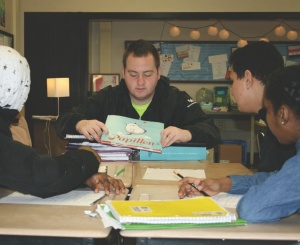
UB undergraduate student Gunnar Haberl engages students in literacy instruction.
Initiated through GSE in spring 2018, a course was designed to provide literacy training to an influx of BPS students who are under refugee status. “There are a large number of multicultural and multilingual students so this literacy training program is meant to close the learning gaps in many of our schools in the Western New York area,” says Christiana Kfouri, a doctoral student and course instructor from the Department of Learning and Instruction.
Kfouri teaches Literacy, Access and Equity: Embracing Diversity to Enrich Our Community. This course examines cultural practices with regard to literacy and provides GSE students with an opportunity to mentor BPS students and teach them early and emergent stages of literacy, such as phonics, phonemic awareness and vocabulary concepts. The course has become the only one of its kind in BPS to satisfy an important educational challenge within the district.
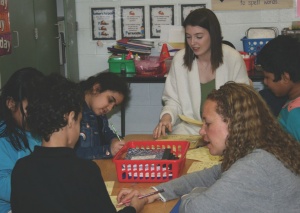
Sydney Wolny (center) and LAI doctoral student Christiana Kfouri (right) engage students in literacy instruction.
BPS understood the need to address early literacy practices with many of its new students. Schools such as BPS #6 (Buffalo Elementary School of Technology) included a vast number of immigrant student populations (children speak 21 different languages aside from English), so they require literacy tutoring tailored to more individual and small group instruction. Kfouri notes that UB’s large population of international students makes it easier for undergraduates to relate to the culturally and linguistically diverse student populations in BPS.
Gunnar Haberl, one of 18 students who completed the literacy course says his experience was rewarding for BPS students and himself as he was able to interact with students on a daily basis.
“Through my conversations with these students, I was able to learn about their heritage and culture,” says Haberl. “There is no better learning than hands-on experience and this course provided the opportunity for aspiring educators to put into practice the theories and tools they are learning from their professors in the classroom.”
Seeing the joy on each BPS student face when Haberl arrived made him look forward to coming into the classroom and reading with them. “Innovative courses like this allow for the students in BPS to learn more about higher education and learn from someone who may not be their day-to-day teacher,” says Haberl. He has always been a strong supporter of collaboration within the community. “What makes a community special is when you have various people with various backgrounds coming together to accomplish a common goal.”
“I am so pleased that GSE is able to play a part in helping to support these students as they strengthen their literacy skills,” says Dean Rosenblith.

Building on a Strong Foundation of Learning
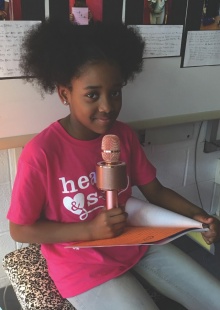
Imari Spain, a student in Jessica Bernstein’s fifth-grade class, prepares to read a selection from her writing portfolio.
An ongoing partnership between the Graduate School of Education and Buffalo Public Schools is helping to improve learning in the BUILD Community School, previously known for being one of the lowest performing schools in Buffalo. GSE is working side-by-side with the new BUILD administration to improve the school’s approaches, outcomes and experiences.
One innovative approach was to bring GSE specialists into BUILD to help revamp the literacy program (see story on page 11). “When speaking with teachers at BUILD about the student writing initiative piloted last school year through the school’s partnership with GSE, you hear words like creativity, empowerment and ownership,” says David Gorlewski, clinical assistant professor from the Department of Educational Leadership and Policy.
Gorlewski began working with seven teacher volunteers to feature daily writing, student collaboration and writing for different audiences. “A key program element was the establishment of a student writing portfolio system that allows teachers and administrators to view student writing programmatically, and to improve their writing over time,” says Gorlewski. He also notes that this innovative approach creates internships for GSE students, which allows them to learn in the community where they will eventually teach.
Jessica Bernstein, a fifth-grade teacher at BUILD, sees a connection for students between freewriting and the motivation to write. “The students truly enjoyed being able to express themselves through freewriting rather than being told to write about a specific topic,” says Bernstein. “They really look forward to writing.”
Students, teachers and BUILD Community School Principal Tanika Shedrick are very pleased with this GSE-led writing initiative. Shedrick thought the approach worked so well that she even asked Gorlewski to implement the writing initiative on a school-wide basis for the 2019–20 school year.
“Perhaps the key outgrowth of this initiative is that BUILD’s students truly see themselves as writers,” Gorlewski says.

Providing Professional Development Opportunities
The New York State Education Department has also agreed to partner with GSE to provide professional development opportunities for teachers and other staff at religious and independent schools. The agreement allows each participant to take up to 12 credits of coursework through GSE at no cost.
“These are courses across all four of our departments so it’s professional development based on what the teacher needs,” says Cory Meyers, GSE director of admission. “All of these courses are taught online, which ultimately saves teachers time.”

Travel with a Purpose
Faculty members from GSE are reaching outside of UB, including travel abroad, to expand their research and develop innovative ways to collect data and conduct studies. These research projects are providing insights from a global perspective.
Amy VanScoy, Associate Professor, Department of Information Science

Amy VanScoy (right) with scholars from Ghana, Nigeria, South Africa and New Zealand at the Nelson Mandela statue in Pretoria, South Africa.
While working on a reference and information services (RIS) project in the United States, VanScoy wanted to think outside the borders. As a result, she decided to expand her project to Slovenia and South Africa.
“I felt like if I was going to make a claim about what librarians do, then I should turn it into a global study,” says VanScoy. “So, I gathered participants from three different countries to provide for a more international perspective.”
The goal of this project is to understand the variety of conflicting librarian approaches to RIS in these countries.
This study uses Q methodology, which involves a card sort and an interview, to identify and examine conceptualizations of RIS by experienced librarians. Q methodology is meant to explore points of views or opinions. The cards that study participants sorted is called the “Q sample” and consisted of 35 statements that reflect conceptualizations of RIS.
The Q samples included statements such as “My job is to teach,” “It’s all about giving the person the answer” and “I think of reference librarianship as being a human services occupation in some ways.” VanScoy notes that the advantage of conducting research abroad is that the library systems are all so different, especially in South Africa.
“South Africa has gone through a cultural upheaval over the last 20 years,” VanScoy says. “The librarians have begun to advocate for more libraries, particularly in schools because they receive so little funding there.” She also notes that Slovenia is different because their library system is so well-organized, and every person in the country has to be within a certain number of kilometers away from a library. This project is still in progress but VanScoy says the data are revealing differing conceptualizations of RIS between Slovenia, South Africa and the United States.
Whether it’s studying librarian preferences or working to reduce gender-based violence, faculty members from GSE are finding innovative new ways to expand their research abroad and gain a new perspective from different countries. “Personally, I find it ethnocentric if I only conduct studies in the United States,” says VanScoy. “I want to do research in other countries because there has to be some differences that we can learn from.”
Stephen Jacobson, UB Distinguished Professor, Department of Educational Leadership and Policy
As a longtime professor at UB, Jacobson has been all over the world teaching courses and participating in many different research projects. Jacobson was brought to Albania to discuss education from an American perspective, and is also involved with a large international research project in India to reduce gender-based violence with the use of prosocial computer games.
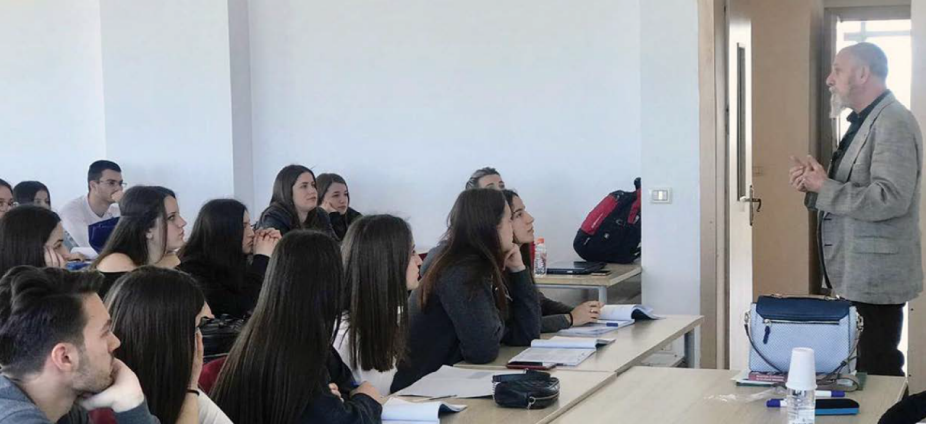
Stephen Jacobson teaching a class at Aleksandër Moisiu University in Albania.
Jacobson traveled to Albania as a Fulbright teaching scholar to give lectures about American public education at Aleksandër Moisiu University (AMU), a public university in Albania. He notes that AMU was the first Albanian university to adopt the American model of higher education, which was a milestone for a country that was once very isolated. “Albania was once a communist government, but they went through a structural change and shifted more towards a democratic system to break out of the rigid thinking that has guided their behavior in the past,” Jacobson says.
In India, Jacobson is participating in a research project titled, “None in Three (Ni3).” The goal of this project is to globally change cultural, social and religious attitudes towards gender-based violence. “The research suggests that one in three women around the world have been physically or sexually abused at some point during their lifetime,” Jacobson says. “This project is working to reduce that number to zero.”
Ni3 spans four different countries, India, Jamaica, Uganda and the United Kingdom, and aims to create story-driven computer games that explore the reality of gender-based violence. Research has shown prosocial computer games can enhance children’s moral reasoning, foster empathy and reduce aggression, which is why Ni3 is creating games to help children develop non-adversarial interpersonal skills. For more information on the Ni3 project, visit www.noneinthree.org.
“Having the opportunity to go abroad, help do research and be involved with so many different projects was such a great experience,” says Jacobson. “I am really looking forward to going back.”

Improving Leadership Skills for Students
The Department of Educational Leadership and Policy (ELP) has developed an innovative approach to the educational administration doctorate in education (EdD) program. Students will now be recruited as a cohort from ELP’s Leadership Initiative For Tomorrow’s Schools (LIFTS) program to the EdD program. Corrie Stone-Johnson, ELP associate professor, says that students would typically apply individually and be admitted independently.
“Our hope is that this will help students develop their leadership skills with a cohort of their peers and a connection to the university faculty and their resources,” says Stone-Johnson. She additionally notes that in the past, students graduated from the LIFTS program, obtained a position as a district leader, worked for several years and then returned to GSE to enter the doctoral program in educational administration.
Stone-Johnson and Thomas Ramming, ELP clinical associate professor, are currently working to combine LIFTS with the EdD educational administration program. Ultimately, GSE students will be encouraged to stay and earn their LIFTS certification and EdD degree in only five years.
“We thought this was another great way to help our students develop their leadership skills,” says Stone-Johnson. “The innovation in this approach is seeing the doctoral component as an extension of leadership preparation.”
The EdD program has also joined the Carnegie Project on the Education Doctorate (CPED), a consortium that includes over 100 colleges and schools of education from the United States and Canada. In collaboration with CPED, GSE is committing resources to undertake a critical examination of the EdD program through dialogue, experimentation, critical feedback and evaluation.
Julie Gorlewski, chair of the Department of Learning and Instruction (LAI), notes that ELP and LAI are participating in CPED to develop and implement cutting-edge theories and practices. For example, she discusses the “Dissertation in Practice,” which is designed for students to address an authentic issue related to their field. “A persistent, contextualized and specific issue embedded in the work of a professional practitioner will create immediate impact by applying theory to practice,” says Gorlewski.

Viewing Education Through a Virtual Lens
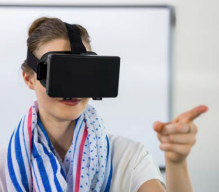
Elisabeth Etopio, assistant dean for teacher education, and Erin Kearney, associate professor from the Department of Learning and In- struction, are using virtual reality (VR) to help improve the teaching abilities of preservice teachers. Within this innovative project they have created a number of VR scenarios, which they are piloting with students in the teacher education program.
One of the programmed VR scenarios that preservice teachers will experience features misbehaving students who are either texting in class or standing on chairs and arguing with their peers. The preservice teachers will then have the option of choosing which interaction to engage in with students.
“We are aiming to immerse our teachers into highly interactive and realistic environments to shape their thinking about pedagogical practices,” says Etopio. “The use of VR is innovative because these teachers can experience real-life scenarios in a safe environment.” Etopio notes that the beauty of utilizing VR in an educational setting is that teachers can hit stop, take the headset off and reassess a situation, which you cannot do in a real classroom.

Transforming Technology in Classrooms
GSE faculty and students are using the latest innovations in technology to enhance the classroom experience for students and improve teaching skills.
Marc Isseks, Doctoral Student, Learning and Instruction
When Isseks first started teaching, he printed exams on a machine that was cranked by hand. Now, he watches students airdrop packets of information into their iPads. Isseks wrote the book “Forward Fast: Making Sense of Education in an Era of Rapid Change,” which explains the changes that have occurred over the past two decades regarding education and technology.
After realizing how quickly technology is advancing, he started to examine the New York State (NYS) testing system and how slowly it adapts to new technology. “All of these transformations have occurred in the world over the past decade and NYS is still trying to iron out the kinks of computer-based testing,” says Isseks. “When you look at a test in NYS, it’s just a computerized version of what you take on paper and that’s not a transformation at all or even a reflection of the kind of change that we need to address.”
Isseks notes that individuals spend a lot of time and money acquiring new technology, but he encourages knowing how to use the technology rather than just having it be there. “It’s not about the tools themselves,” says Isseks. “It’s about how you use the tools that make the difference.”
As an assistant principal at New Hyde Park Memorial High School in New Hyde Park, N.Y., his goal is to have a significant impact on how teachers use technology in the classroom and utilize that technology to educate their students.
“I want to amplify my voice in whatever way I can,” says Isseks. “I want to have an impact on how teachers educate their students and just be a part of that conversation.”
Mary McVee and Lynn Shanahan, Professor and Associate Professor Emeritus, Learning and Instruction
In education courses and professional development settings, it is common to ask preservice and inservice teachers to reflect individually in writing. Although reflecting in this manner is valuable, it does not give teachers a chance to co-construct knowledge with multiple modes of communication (e.g., movies, images, talking and writing).
To address this concern, McVee and Shanahan (who retired from UB in August 2019; see story on page 37) are using video reflection as a tool to mediate teachers’ understanding of their pedagogical practices. They are working with GSE’s Center for Literacy and Reading Instruction (CLaRI) and the Amherst Central School District (ACSD) to implement a video-learning reflection tool with kindergarten through second grade science teachers for the 2019–20 school year.
CLaRI has had a longstanding partnership focused on literacy with ACSD, but recent focus has shifted to have inservice teachers use video reflection on their pedagogical practices. One of the goals is for teachers to develop effective teaching practices with their increasingly diverse population, as 28 different languages are spoken with students from 32 different countries.
“We are using a technological system called Swivl, and the benefit of Swivl is that it captures teacher’s lessons, provides space to annotate their lessons so teachers can identify their areas of development, and provides a platform to share their lessons if they choose to,” says Shanahan.
Another main goal of video reflection is to provide a learning space for teachers to reflect on new teaching methods across multiple years so they can feel more comfortable with how they teach and also impact learning.
“If we build the capacity of teacher learning around video reflection, then the prediction is that instructional delivery will be stronger, particularly in target areas related to language and literacy,” says McVee. “With more intensive teacher development, students should also have the opportunities to engage in rich language, literacy, and science practices to think and engage more intensively and actively to positively affect student learning.”
Noemi Waight, Associate Professor, Learning and Instruction
As an expert in the field of technology and education, Waight is also taking full advantage of the technological tools that are advancing at such a rapid pace in today’s world. Her research helps explain the nature of technology as it relates to K–12 education. She also examines the factors that impact the adoption, design, development and implementation of technology in STEM (science, technology, engineering and mathematics) education.
Waight highlights the use of Probeware, which is an innovative technological tool used to help students analyze and collect data.
“If you have 30 students in a classroom and they are collecting data at the same time, what they will find is that even though they were collecting data in the same location, there might be slight differences in their data and the immediacy of access to the data,” says Waight.
“Probeware allows students to interrogate these discrepancies and ensue a discussion that can help students visualize their data and understand the need for multiple trials and data points.”
Waight explains that the crux of technology use for science teaching and learning is ensuring technologies are appropriate and they align with the goal of demonstrating to students that science is a dynamic process. “Science is about doing,” Waight says. “Essentially, this provides opportunities for students to engage with and understand the scientific process.”



